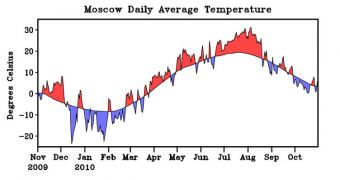According to the conclusions of a scientific study, it would appear that the deadly heat wave which claimed the lives of thousands of Russians in 2010 was caused by natural variability.
While this particular heat wave was not caused by climate change or global warming, the researchers caution that the natural atmospheric phenomenon often associated with these weather extremes is likely to intensify as the result of a warming world.
Russia will be especially hard-hit by this, because the aforementioned phenomenon exerts its effects predominantly on this region. These conclusions are based on both scientific observations and computer climate models.
During the investigation, scientists with the US National Oceanic and Atmospheric Administration (NOAA) sought to determine the roles that natural variability and human influences had on the heat.
They also wanted to determine which of the two had the decisive influence in the final outcome. Their conclusions have been accepted for publication in an upcoming issue of the esteemed journal Geophysical Research Letters.
“Knowledge of prior regional climate trends and current levels of greenhouse gas concentrations would not have helped us anticipate the 2010 summer heat wave in Russia,” lead author Randall Dole argues.
“Nor did ocean temperatures or sea ice status in early summer of 2010 suggest what was to come in Russia,” adds the expert, who is the deputy director of research at the NOAA Earth System Research Laboratory (ESRL) Physical Science Division.
He is also a fellow of the Cooperative Institute for Research in Environmental Sciences (CIRES).
From July to mid-August, 2010, the western parts of Russia were blasted with temperatures ranging from 90 to above 100 degrees Fahrenheit (32 to 37+ degrees Celsius). This average also includes night-time temperatures.
Such a prolonged heat wave caused poor air quality, crop failures on a massive scale and massive wildfires, and eventually led to the death of more than 56,000 people in Moscow and other areas.
“It appears that parts of Russia are on the cusp of a period in which the risk of extreme heat events will increase rapidly,” adds ESRL research meteorologist and study coauthor Martin Hoerling.
He explains that climate change did play a role in generating the heat wave, but adds the the phenomenon had a smaller influence than a naturally-occurring meteorological process in the area.
“We know that climate change is not taking place at the same rate everywhere on the globe. Western Russia is one of the parts of the world that has not seen a significant increase in summertime temperatures. The US Midwest is another,” Hoerling concludes.

 14 DAY TRIAL //
14 DAY TRIAL //